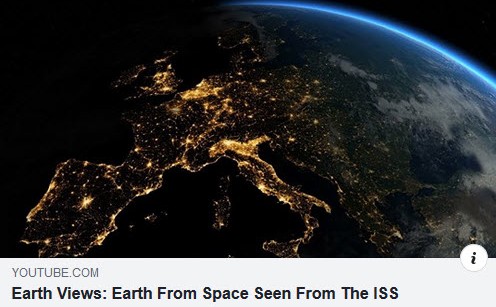Earth from NASA: Difference between revisions
Siterunner (talk | contribs) No edit summary |
Siterunner (talk | contribs) No edit summary |
||
| Line 10: | Line 10: | ||
NASA's original "Mission Statement" in 1958 spoke of the goal of studying the home planet for the benefit of humanity. | NASA's original "Mission Statement" in 1958 spoke of the goal of studying the home planet for the benefit of humanity. | ||
Today's mission statement includes the following: NASA mission statement ... to “drive advances in science, technology, aeronautics, and space exploration to enhance knowledge, education, innovation, economic vitality and stewardship of Earth.” | |||
Planet Citizens, Planet Scientists continue to this day to study earth from space and gather critical data. | |||
An era of earth science missions beginning in the 1960's have brought together visionary thinking and scientific minds. | |||
[https://www.greenpolicy360.net/w/Planet_Citizens,_Planet_Scientists Planet Citizens, Planet Scientists] continue to this day to study earth from space and gather critical data. | |||
The International Space Station (ISS) is now providing live HDTV video. Watch the home planet as we roll! | The International Space Station (ISS) is now providing live HDTV video. Watch the home planet as we roll! | ||
UStream live Feed From the NASA HDEV live cameras aboard the ISS | UStream live Feed From the NASA HDEV live cameras aboard the ISS: | ||
http://www.ustream.tv/channel/live-iss-stream | http://www.ustream.tv/channel/live-iss-stream | ||
| Line 25: | Line 28: | ||
Additional NASA earth from space channels: | Additional NASA earth from space channels: | ||
https://www.youtube.com/watch?v=5_rLJNq7Rw8 | https://www.youtube.com/watch?v=5_rLJNq7Rw8 | ||
| Line 33: | Line 35: | ||
https://www.youtube.com/watch?v=EEIk7gwjgIM | https://www.youtube.com/watch?v=EEIk7gwjgIM | ||
https://www.youtube.com/watch?v=XBPjVzSoepo | https://www.youtube.com/watch?v=XBPjVzSoepo | ||
| Line 41: | Line 42: | ||
Watch the Earth from the International Space Station. Live and pre-recorded... | |||
Earth seen from cameras aboard the International Space Station. | |||
Approximate 90 minute orbits and with a 90 minute orbit and 24 hour day, the ISS circles the Earth 16 times a day. That's 16 sunrises and 16 sunsets each 'orbital day'. The ISS passes from a period of night, every 45 minutes when live video is unavailable and depending on the channel you are watching other pre-recorded footage may be shown until live transmission resumes when the space station returns to daylight. | |||
NASA ISS live streaming is courtesy of www.nasa.gov and its partners. | NASA ISS live streaming is courtesy of www.nasa.gov and its partners. | ||
Revision as of 22:45, 26 June 2020
Earth viewing from the International Space Station
NASA's original "Mission Statement" in 1958 spoke of the goal of studying the home planet for the benefit of humanity.
Today's mission statement includes the following: NASA mission statement ... to “drive advances in science, technology, aeronautics, and space exploration to enhance knowledge, education, innovation, economic vitality and stewardship of Earth.”
An era of earth science missions beginning in the 1960's have brought together visionary thinking and scientific minds.
Planet Citizens, Planet Scientists continue to this day to study earth from space and gather critical data.
The International Space Station (ISS) is now providing live HDTV video. Watch the home planet as we roll!
UStream live Feed From the NASA HDEV live cameras aboard the ISS:
http://www.ustream.tv/channel/live-iss-stream
http://www.ustream.tv/channel/iss-hdev-payload
Additional NASA earth from space channels:
https://www.youtube.com/watch?v=5_rLJNq7Rw8
https://www.youtube.com/watch?v=DDU-rZs-Ic4
https://www.youtube.com/watch?v=EEIk7gwjgIM
https://www.youtube.com/watch?v=XBPjVzSoepo
Watch the Earth from the International Space Station. Live and pre-recorded...
Earth seen from cameras aboard the International Space Station.
Approximate 90 minute orbits and with a 90 minute orbit and 24 hour day, the ISS circles the Earth 16 times a day. That's 16 sunrises and 16 sunsets each 'orbital day'. The ISS passes from a period of night, every 45 minutes when live video is unavailable and depending on the channel you are watching other pre-recorded footage may be shown until live transmission resumes when the space station returns to daylight.
NASA ISS live streaming is courtesy of www.nasa.gov and its partners.
·····································································
Planet Citizens, Planet Scientists
Our Time Is Now
Planet Citizen / Planet Citizens
Sharing an Earth Point of View
#Earth360 | #EarthMonitoring |
#EarthObservations | #EarthScience
○
- Arctic
- Biodiversity
- Climate Change
- Climate Policy
- Digital Citizen
- Earth360
- Earth Imaging
- Earth Law
- Earth Observations
- Earth Science
- Earth Science from Space
- Earth System Science
- Eco-nomics
- Eco-Spirituality
- Ecology Studies
- Ecoregions
- Education
- Environmental Full-cost Accounting
- Environmental Security
- Environmental Security, National Security
- EOS eco Operating System
- ESA
- Externalities
- Fisheries
- Forests
- Food-Related Policies
- Global Security
- Global Warming
- ISS
- Land Ethic
- Maps
- NASA
- Natural Resources
- New Definitions of National Security
- New Space
- Oceans
- Ocean Ecosystem
- Ocean Science
- Ocean Sustainability
- Planet Citizen
- Planet Citizens
- Planet Scientist
- Planet Citizens, Planet Scientists
- Sea-Level Rise & Mitigation
- Solar Energy
- Strategic Demands
- Sustainability
- Sustainability Policies
- ThinBlueLayer
- Threat Multiplier
- US Environmental Protection Agency
- Whole Earth
- World Wide Web
- Atmospheric Science
- Biogeosciences
- Cryosphere
- Geophysics and Geochemistry
- Mineralogy
- Geology
- Geophysics
- Hydrology
- Planetary Science
- Space Science and Space Physics
